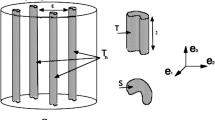We extend the method of maximal advance paths to the case of elastic homogenization of materials with composite network microstructure. Some distributions of the vectors of stretching of the links for each component are introduced in the representations of network microstrains. On the basis of the refined statistics of orientations of links in the maximal advance paths, we obtain a new formulation of the kinematic relation connecting these micromechanical variables with macroscopic strains in the material. The problem of determination of the network balance is solved by the intermediate averaging of strains and the response of links with identical initial orientations. As a result, different components of the network are replaced with an equivalent link. Within the framework of the proposed model, we establish the series character of their joining and the transmission of forces in the network. We also analyze the qualitative differences in the behaviors of materials with different structures, which can be explained by the geometric and physical properties of elements of the composite network microstructures.
Similar content being viewed by others
References
M. M. Tkachuk, “Method of elastic homogenization of bimodal networks,” Visnyk Nats. Tekh. Univ. “KhPI,” Ser. Mashynoznavstvo SAPR, No. 7, 107–115 (2019); https://doi.org/10.20998/2079-0775.2019.7.17.
J. R. Blundell and E. M. Terentjev, “Forces and extensions in semiflexible and rigid polymer chains and filaments,” J. Phys., Ser. A: Math. Theor., 40, No. 36, 10951–10964 (2007); https://doi.org/10.1088/1751-8113/40/36/001.
N. Chen and M. N. Silberstein, “A micromechanics-based damage model for non-woven fiber networks,” Int. J. Solids Struct., 160, 18–31 (2019); https://doi.org/10.1016/j.ijsolstr.2018.10.009.
C. Creton, “50th anniversary perspective: Networks and gels: Soft but dynamic and tough,” Macromolecules, 50, No. 21, 8297–8316 (2017); https://doi.org/10.1021/acs.macromol.7b01698.
J. Diani and P. Le Tallec, “A fully equilibrated microsphere model with damage for rubber-like materials,” J. Mech. Phys. Solids, 124, 702–713 (2019); https://doi.org/10.1016/j.jmps.2018.11.021.
E. S. Dragan, “Design and applications of interpenetrating polymer network hydrogels. A review,” Chem. Eng. J., 243, 572–590 (2014); https://doi.org/10.1016/j.cej.2014.01.065.
B. Erman and J. E. Mark, “Use of the Fixman–Alben distribution function in the analysis of non-Gaussian rubber-like elasticity,” J. Chem. Phys., 89, No. 5, 3314–3316 (1988); https://doi.org/10.1063/1.454938.
A. Gloria, P. Le Tallec, and M. Vidrascu, “Foundation, analysis, and numerical investigation of a variational network-based model for rubber,” Continuum Mech. Thermodynam., 26, No. 1, 1–31 (2014); https://doi.org/10.1007/s00161-012-0281-6.
J. P. Gong, Y. Katsuyama, T. Kurokawa, and Y. Osada, “Double-network hydrogels with extremely high mechanical strength,” Adv. Mater., 15, No. 14, 1155–1158 (2003); https://doi.org/10.1002/adma.200304907.
S. Govindjee, M. J. Zoller, and K. Hackl, “A fully-relaxed variationally consistent framework for inelastic micro-sphere models: Finite viscoelasticity,” J. Mech. Phys. Solids, 127, 1–19 (2019); https://doi.org/10.1016/j.jmps.2019.02.014.
M. Kroon, “A constitutive model for strain-crystallising rubber-like materials,” Mech. Mater., 42, No. 9, 873–885 (2010); https://doi.org/10.1016/j.mechmat.2010.07.008.
A. Kulachenko and T. Uesaka, “Direct simulations of fiber network deformation and failure,” Mech. Mater., 51, 1–14 (2012); https://doi.org/10.1016/j.mechmat.2012.03.010.
M. A. Llorente, A. L. Andrady, and J. E. Mark, “Model networks of end-linked polydimethylsiloxane chains. XI. Use of very short network chains to improve ultimate properties,” J. Polym. Sci., Ser. A2, 19, No. 4, 621–630 (1981); https://doi.org/10.1002/pol.1981.180190406.
J. E. Mark, “Elastomeric networks with bimodal chain-length distributions,” Acc. Chem. Res., 27, No. 9, 271–278 (1994); https://doi.org/10.1021/ar00045a003.
C. Miehe, S. Göktepe, and F. Lulei, “A micro-macro approach to rubber-like materials. Part I: the non-affine micro-sphere model of rubber elasticity,” J. Mech. Phys. Solids, 52, No. 11, 2617–2660 (2004); https://doi.org/10.1016/j.jmps.2004.03.011.
R. Rastak and C. Linder, “A non-affine micro-macro approach to strain-crystallizing rubber-like materials,” J. Mech. Phys. Solids, 111, 67–99 (2018); https://doi.org/10.1016/j.jmps.2017.10.007.
J. Y. Sun, X. Zhao, W. R. K. Illeperuma, O. Chaudhuri, K. H. Oh, D. J. Mooney, J. J. Vlassak, and Z. Suo, “Highly stretchable and tough hydrogels,” Nature, 489, 133–136 (2012); https://doi.org/10.1038/nature11409.
M. Tkachuk and C. Linder, “The maximal advance path constraint for the homogenization of materials with random network microstructure,” Philos. Mag., Part A: Mater. Sci., 92, No. 22, 2779–2808 (2012); https://doi.org/10.1080/14786435.2012.675090.
E. Verron, “Questioning numerical integration methods for microsphere (and microplane) constitutive equations,” Mech. Mater., 89, 216–228 (2015); https://doi.org/10.1016/j.mechmat.2015.06.013.
Q. Wang, R. Hou, Y. Cheng, and J. Fu, “Super-tough double-network hydrogels reinforced by covalently compositing with silicananoparticles,” Soft Matter., 8, No. 22, 6048–6056 (2012); https://doi.org/10.1039/C2SM07233E.
Z. Wang, C. **ang, X. Yao, P. Le Floch, J. Mendez, and Z. Suo, “Stretchable materials of high toughness and low hysteresis,” Proc. Nat. Acad. Sci. USA, 116, No. 13, 5967–5972 (2019); https://doi.org/10.1073/pnas.1821420116.
X. Zhao, “Multi-scale multi-mechanism design of tough hydrogels: building dissipation into stretchy networks,” Soft Matter., 10, No. 5, 672–687 (2014); https://doi.org/10.1039/c3sm52272e.
Author information
Authors and Affiliations
Corresponding author
Additional information
Translated from Matematychni Metody ta Fizyko-Mekhanichni Polya, Vol. 62, No. 3, pp. 92–105, July–September, 2019.
Rights and permissions
About this article
Cite this article
Тkachuk, М.М. Elastic Homogenization of Materials with Composite Network Structures. J Math Sci 263, 104–119 (2022). https://doi.org/10.1007/s10958-022-05910-z
Received:
Published:
Issue Date:
DOI: https://doi.org/10.1007/s10958-022-05910-z




